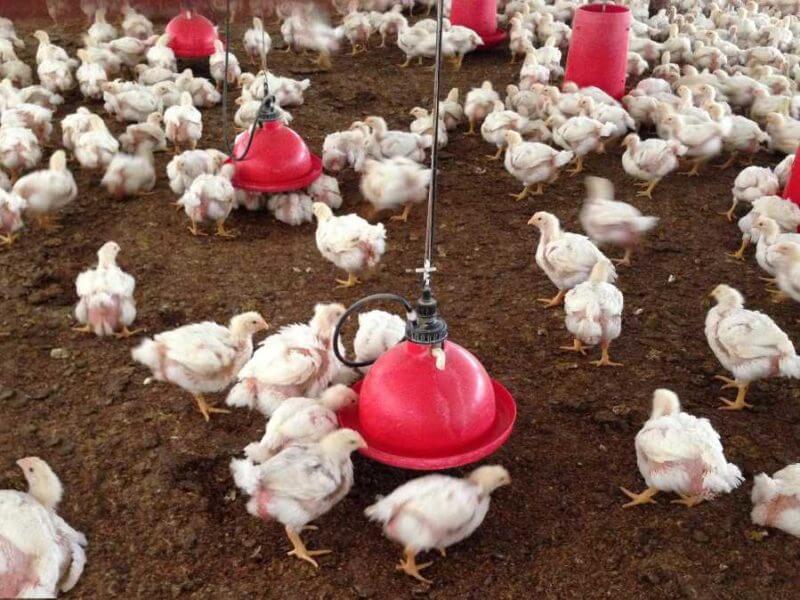The inclusion of a high-flavonoid corn, developed by a Penn State maize geneticist, in the diet of broiler chickens reduced the incidence and severity of a fatal intestinal disorder known as necrotic enteritis.
The results are especially important, according to study leader Gino Lorenzoni, assistant professor of poultry science and avian health in the College of Agricultural Sciences, because they come at a time when poultry producers are reducing their reliance on antibiotics to keep birds healthy. Due to concern about the emergence of antibiotic-resistant pathogens, producers need help keeping disease at bay among their flocks.
“Poultry producers are not using antibiotics the way they were before,” said Lorenzoni, who also is a Penn State Extension veterinarian. “The European Union in 2006 banned the use of antibiotics as growth promoters in animal feed, and half of the chickens that are raised in the United States are raised without antibiotics. That is 4 billion chickens in this country, alone. There is a huge need for alternatives to antibiotics to keep this massive population of chickens healthy.”
Necrotic enteritis is one of the most devastating diseases in poultry, Lorenzoni noted. Afflicting mostly broiler chicks just a few weeks old, the intestinal disease produces massive economic losses. It has been estimated that the disease could cost $6 billion every year worldwide due to losses in productivity and costs involving treatment and prevention.
The high-flavonoid specialty corn PennHFD used in this research, which was conducted at Penn State’s Poultry Education and Research Center, was developed by study co-author Surinder Chopra, professor of maize genetics. In recent years, he bred this novel line of corn that is rich with compounds called flavonoids,at Penn State’s Russell E. Larson Agricultural Research Center.
Related powerful antioxidant compounds have been shown by Chopra and colleagues to have a positive effect on mice health. In an experiment published in 2020, mice with an induced inflammation of the colon were judged to significantly improve after being fed corn.
This latest research — led by Vinicius Buiatte, a doctoral degree candidate in the Department of Animal Science — included 400 broiler chickens with necrotic enteritis and compared a diet based on commercially available corn to the effects of a diet based on PennHFD.
In findings recently published in Poultry Science, birds fed the PennHFD-based diet had a 48% lower incidence of intestinal lesions, higher body weight gain, a better feed-conversion ratio and a 23% lower mortality rate compared to chicks fed the control diet. The evidence of a reduction in intestinal inflammation in the chicks, the researchers pointed out, is consistent with anecdotal poultry industry reports that flavonoid-rich feed additives improve the growth performance and immunity of birds, even in the absence of clinical disease.
Although the mechanisms of action of the high-flavonoid corn in reducing necrotic enteritis in chickens were not investigated in this study, the researchers speculated that the anti-inflammatory and antibacterial properties of flavonoids play a key role in the control of this disease. They suggested that high-flavonoid corn may serve as an effective alternative for improving health and performance in the absence of antimicrobials in chickens.
Therefore, Penn State has applied for a provisional patent on feeding PennHFD as a poultry therapy.
“More research is being performed to understand the dosage effect of PennHFD corn in chicken diets, and further experiments need to be conducted to understand the biochemical process that resulted in amelioration of the inflammatory process seen in this study,” Lorenzoni said. “We believe we can make a difference for the poultry industry, and we think we are just a few years away.”
Also contributing to the research at Penn State were Dorian Dominguez, research associate in the Department of Animal Science, and Tyler Lesko, doctoral degree student in the Department of Plant Science; and Mark Jenkins, a researcher with the U.S. Department of Agriculture’s Animal Parasitic Diseases Laboratory, Beltsville, Maryland.
This work was partially funded by the U.S. Department of Agriculture’s National Institute of Food and Agriculture. This project received support from the Motivating Innovation and Seeding Technologies fund, an invitation-only grant program designed to help early-stage technologies move toward commercialization. This funding, administered by the College of Agricultural Sciences’ Entrepreneurship and Innovation Program, is often used to help strengthen the patent position for new intellectual property.


